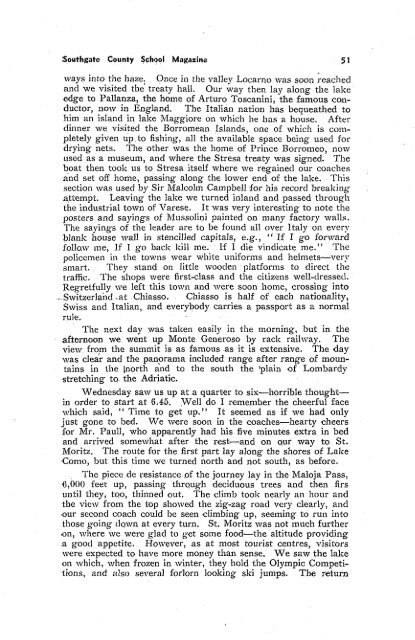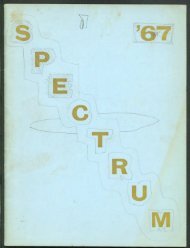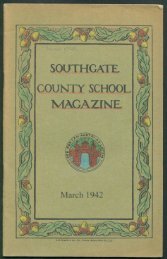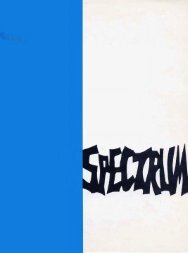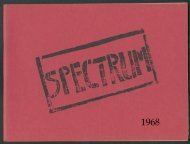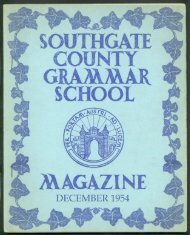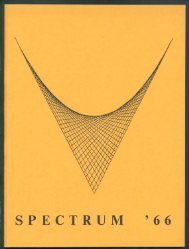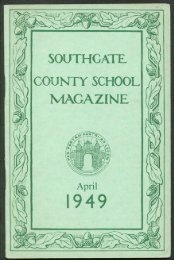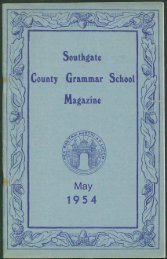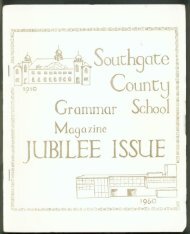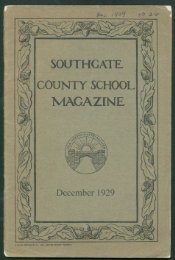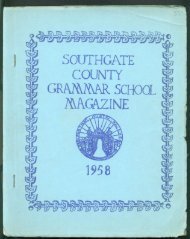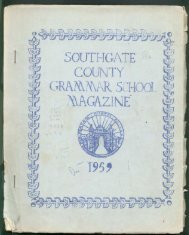No 34 - December 1937 - Southgate County School
No 34 - December 1937 - Southgate County School
No 34 - December 1937 - Southgate County School
You also want an ePaper? Increase the reach of your titles
YUMPU automatically turns print PDFs into web optimized ePapers that Google loves.
<strong>Southgate</strong> <strong>County</strong> <strong>School</strong> Magazine 51<br />
ways into the haze. Once in the valley Locarno was soon reached<br />
and we visited the treaty hall. Our way then lay along the lake<br />
edge to Pallanza, the home of Arturo Toscanini, the famous conductor,<br />
now in England. The Italian nation has bequeathed to<br />
him an island in lake Maggiore on which he has a house. After<br />
dinner we visited the Borromean Islands, one of which is completely<br />
given up,to fishing, all the available space being used for<br />
drying nets. The other was the home of Prince Borromeo, now<br />
used as a museum, and where the Stresa treaty was signed. The<br />
boat then took us to Stresa itself where we regained our coaches<br />
and set off home, passing along the lower end of the lake. This<br />
section was used by Sir Malcolm Campbell for his record breaking<br />
attempt. Leaving the lake we turned inland and passed through<br />
the industrial town of Varese. It was very interesting to note the<br />
posters and sayings of Mussolini painted on many factory walls.<br />
The sayings of the leader are to be found all over Italy on every<br />
Wank house wall in stencilled capitals, e.g., " If I go forward<br />
follow me, If I go back kill me. If I die vindicate me." The<br />
policemen in the towns wear white uniforms and helmets—very<br />
smart. They stand on little wooden platforms to direct the<br />
traffic. The shops were first-class and the citizens well-dressed.<br />
Regretfully we left this town and were soon home, crossing into<br />
..Switzerland-.at Chiasso. Chiasso is half of each nationality,<br />
Swiss and Italian, and everybody carries a passport as a normal<br />
rule.<br />
The next day was taken easily in the morning, but in the<br />
afternoon we went up Monte Generoso by rack railway. The<br />
view from the summit is as famous as it is extensive. The day<br />
was clear and the panorama included range after range of mountains<br />
in the (north and to the south the 'plain of Lombardy<br />
stretching to., the Adriatic.<br />
Wednesday saw us up at a quarter to six—horrible thought—<br />
in order to start at 6.45. Well do I remember the cheerful face<br />
which said, " Time to get up." It seemed as if we had only<br />
just gone to bed. We were soon in the coaches—hearty cheers<br />
for Mr. Paull, who apparently had his five minutes extra in bed<br />
and arrived somewhat after the rest—and on qur way to St.<br />
Moritz. The route for the first part lay along the shores of Lake<br />
•Como, but this time we turned north and not south, as before.<br />
The piece, de resistance of the journey lay in the Maloja Pass,<br />
•6,000 feet up, passing through deciduous trees and then firs<br />
until they, too, thinned out. The climb took nearly an hour and<br />
the view from the top showed the zig-zag road very clearly, and<br />
our second coach could be seen climbing up, seeming to run into<br />
those going dqwn at every turn. St. Moritz was not much further<br />
•on, where we were glad to get some food—the altitude providing<br />
,a good appetite. However, .as at most tourist centres, visitors<br />
were expected to have more money than sense. We saw the lake<br />
on which, when frozen in winter, they hold the Olympic Competitions,<br />
and also several forlorn looking ski jumps. The return


